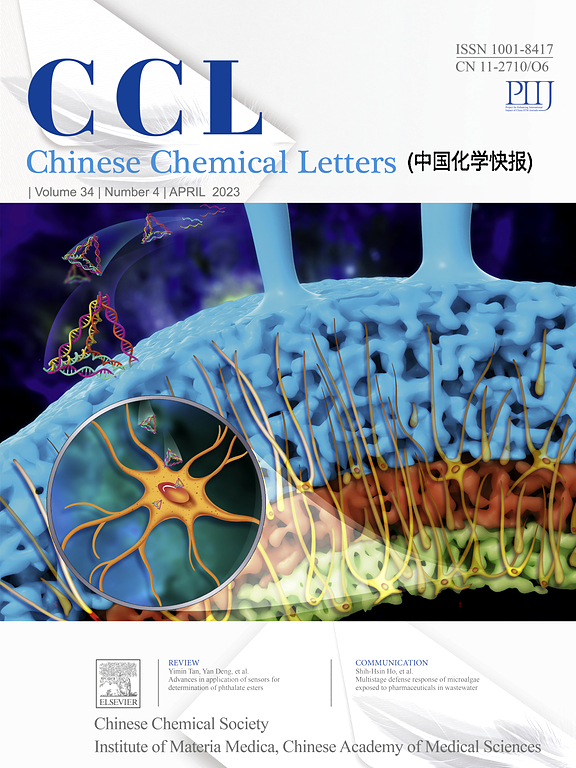Dye-mediated FRET strategy for constructing semi-synthetic large Stokes shift far-red fluorescent protein
IF 8.9
1区 化学
Q1 CHEMISTRY, MULTIDISCIPLINARY
引用次数: 0
Abstract
Red fluorescent proteins with large Stokes shift (LSS-RFPs) are advantageous for multicolor imaging applications that allow simultaneous visualizations of multiple biological events. But it is difficult to develop LSS-RFPs by extending the emission wavelength of RFPs to far-red region. Here, we employed Förster resonance energy transfer (FRET) strategy to engineer the far-red fluorescent proteins with large Stokes shift. LSS-mApple and LSS-mCherry were constructed by fusing HaloTag to mApple and mCherry, allowing the fluorophore TMSiR to be connected to these RFPs. FRET between RFPs and TMSiR enabled them to apply the excitation of donor RFPs to emit far-red fluorescence of acceptor TMSiR. The Stokes shifts of LSS-mApple and LSS-mCherry were 97 nm and 75 nm, respectively. The high FRET efficiency of LSS-mCherry (EFRET = 83.7 %) can greatly reduce the fluorescence from the donor channel, which did not affect co-imaging with mCherry. In addition, LSS-mCherry also showed excellent photostability (t1/2 = 449.3 s), enabling stable confocal fluorescence imaging for 15 min under continuous strong excitation. Furthermore, LSS-mCherry was applied for fluorescence labeling and imaging of the nucleus, mitochondria, lysosomes, and endoplasmic reticulum in living cells. Finally, we applied LSS-mCherry to perform multi-color bioimaging of 2–4 channels, and there was no obvious crosstalk between these channels.

染料介导的FRET策略构建半合成大斯托克斯位移远红色荧光蛋白
具有大斯托克斯位移(LSS-RFPs)的红色荧光蛋白有利于多色成像应用,允许同时可视化多个生物事件。但是通过将rfp的发射波长扩展到远红区域来开发lss - rfp是很困难的。在这里,我们采用Förster共振能量转移(FRET)策略来设计具有大斯托克斯位移的远红色荧光蛋白。通过将HaloTag与mApple和mCherry融合构建LSS-mApple和LSS-mCherry,使荧光团TMSiR连接到这些rfp上。rfp和TMSiR之间的FRET使它们能够利用供体rfp的激发来发射受体TMSiR的远红色荧光。LSS-mApple和LSS-mCherry的Stokes位移分别为97 nm和75 nm。LSS-mCherry的高FRET效率(EFRET = 83.7 %)可以大大降低来自供体通道的荧光,但不影响与mCherry的共成像。此外,LSS-mCherry还表现出优异的光稳定性(t1/2 = 449.3 s),在连续强激发下可实现15 min的稳定共聚焦荧光成像。此外,LSS-mCherry应用于活细胞的细胞核、线粒体、溶酶体和内质网的荧光标记和成像。最后,我们使用LSS-mCherry对2-4个 通道进行了多色生物成像,这些通道之间没有明显的串扰。
本文章由计算机程序翻译,如有差异,请以英文原文为准。
求助全文
约1分钟内获得全文
求助全文
来源期刊

Chinese Chemical Letters
化学-化学综合
CiteScore
14.10
自引率
15.40%
发文量
8969
审稿时长
1.6 months
期刊介绍:
Chinese Chemical Letters (CCL) (ISSN 1001-8417) was founded in July 1990. The journal publishes preliminary accounts in the whole field of chemistry, including inorganic chemistry, organic chemistry, analytical chemistry, physical chemistry, polymer chemistry, applied chemistry, etc.Chinese Chemical Letters does not accept articles previously published or scheduled to be published. To verify originality, your article may be checked by the originality detection service CrossCheck.
 求助内容:
求助内容: 应助结果提醒方式:
应助结果提醒方式:


